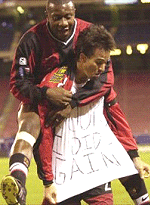|
| |
 |
|
|
Faria and Valencia, 2001
|
History of Metro forward tandems
August 5, 2010
Giovanni Savarese scored the first goal in Metro history. And (if you don't count an own goal), the second. And the third. And the fourth. He got to eight before another player, A.J. Wood, finally got on the scoreboard. The 1996 MetroStars started out as a one-forward team, when two forwards are usually necessary to succeed. And that has been pretty much this story of this franchise since.
So it started as Savarese and Wood. The latter was clearly not up to par (5 goals on the season), the former was great with 14 (this, as all numbers are in all competitions). A striking partner was sought, and after Ruben Dario Hernandez failed (no goals), "El Pitufo" De Avila tore it up, arriving late to score 8 in just 11 games.
Savarese and De Avila had a good connection in 1997, with Gio getting 14 again, and Pitufo's rate falling, but still good enough to net him 9. He was sold after the season, and in came Eduardo Hurtado, who immediately forged a understanding with Gio. 12 goals for "El Tanque", 16 for the Metro hero.
But in 1999, the hero was no more, as the idiotic Bora Milutinovic dumped Savarese to New England. "El Tanque" became "El Stanque", missing sitter after sitter and falling to 7 goals (which seems about four too many). His partner? The second leading scoring forward was Henry Zambarano, with 3 in 14 games. God, did 1999 suck.
In 2000, Hurtado and Zambarano were dumped, and in Colombians Adolfo Valencia and Alex Comas. But it was the acquisition of Clint Mathis that finally gave Metro a killer striking duo. Valencia got 21, still an all-competition record. Mathis ended with 18, and Comas with 14 and Metro often employed a three-forward setup.
We had high hopes for 2001, but it was not to be. Comas slumped to 2 goals and was cut mid-season. Mathis started on a tear, but then tore his ACL. By the end, the starting tandem was Valencia, who saw his production drop to 8, and rookie Rodrigo Faria, who ended with 11.
A year later, Valencia was gone, Mathis was away for large chunks with team USA, and Faria once again led the team, this time with 14. The second best was Mamadou Diallo's 11... so it was a capable tandem, as much as we hate Diallo.
And now, the dark days of Metro strikers begin. For on Bob Bradley's teams, most of the offense came from the midfield in the form of Amado Guevara. Yes, he tried to get a quality striker, trading for Jaime Moreno, but the fat one failed to produce, getting all of two goals before shutting it down. Mathis ended with 10, John Wolyniec and rookie Mike Magee both put in 7.
|
| |
 |
|
| Angel and Altidore, 2007 |
In 2004, Mathis left, and Bradley went all out to get a capable striker. In came Cornell Glen (6 goals), Fabian Taylor (5 goals), and the incredibly expensive Sergio Galvan Rey (2! goals). At the end, the leading striker was Wolyniec with 10. In 2005, Galvan Rey improved (there was no way to go but up), getting 8 goals, and the wonderful Youri Djorkaeff conjured his way to 11.
A year later, Djorkaeff was no longer a forward, and no longer wonderful. The leading forward scorers that season? Jean-Philippe Peguero, who was acquired and then sold in mid-season, with 6, and Edson Buddle, who didn't even make it of the bench by the playoffs, with 6 as well.
2007 saw the arrival of the man who will finally break all of Savarese's scoring records. Juan Pablo Angel tallied 20 in his first MLS season, and budding star Jozy Altidore added 9. In 2008, Jozy was sold early in the year, so Angel's 16 was complemented by an array of players, with Magee getting 5. And in 2009... Ugh. Angel with 12 goals, Mac Kandji and Wolyniec with 4. Stupid 2009.
Which brings us to this year. Angel already has 11, but it's not the 3-goal Salou Ibrahim or the 1-goal Kandji that will be his striking partner for the rest of the year. It will be Thierry Henry, and one can only hope that this tandem will eclipse all the ones that came before.
|
